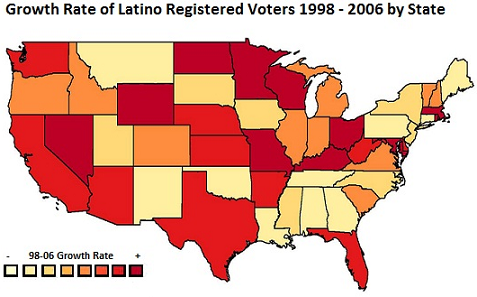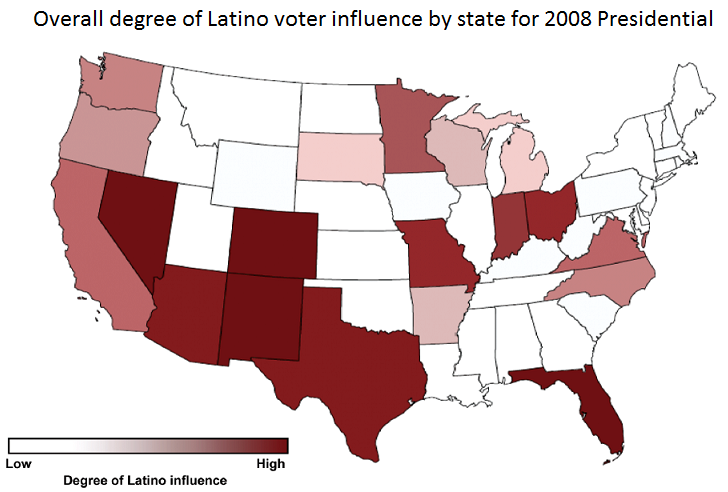By: Matt Barreto, Loren Collingwood, Sylvia Manzano
The importance of the Latino electorate has been the subject of both academic inquiry and media discourses. The question of Latino influence is frequently limited by an approach that focuses on single variable considerations (e.g., voter turnout or ethnic-targeted campaign spending) that are often contest-specific idiosyncrasies. Relying on theoretically appropriate concepts, we measure Latino political influence as a function of three factors: in-group population traits, electoral volatility, and mobilization (research paper here). Using the 2008 presidential election as an example, we demonstrate the utility of incorporating a multifaceted measure that accounts for the contemporary complexity within the electoral environment. Because this framework is rooted in theoretical concepts, as opposed to discrete group or contest characteristics, it may be applied to any “influence group” in different electoral settings. Data are culled from several publicly available outlets, making it possible for election observers to replicate these measures and further investigate questions associated with group influence in American politics.
Applying this model to 2010, there are many states where Latinos could possibly influence the outcome of statewide elections including California, Nevada, Colorado, New Mexico, Illinois, Florida, Rhode Island, Massachusetts, Connecticut, Pennsylvania and Ohio.

We argue that a framework incorporating several dimensions of political influence is necessary to advance the research in a manner that is attentive to contemporary dynamics in the electorate. To this end, we identify three dimensions to measure Latino influence in electoral politics: (1) demographics, measured as coethnic group size and growth rate in the state; (2) electoral volatility, specifically changes in
registration rates, partisan preference, or turnout compared to prior contests; and (3) mobilization, measured as media coverage and resources devoted to courting Latino votes.
Using these three broad categories, we assess a wide array of data, nearly all of them publicly available, to create an overall index of Latino influence in each of the fifty states during the 2008 election, however this general can be applied over time to 2010 or 2012 without difficulty. This approach moves beyond a zero-sum definition of political clout that neglects these consequential realms of influence. Considering multiple aspects of political influence opens up avenues to investigate the extent to which different groups’ influence in politics is conditioned on the combination and variation in group demographics, voting behavior, and mobilization. Because this framework is rooted in theoretical concepts as opposed to discrete group characteristics, it can be applied to multiple minority or “influence groups” (e.g., African Americans, religious conservatives, working mothers, etc.) in different types of elections.

How we measure Latino influence
In this study, we provide metrics, and easy to read state-by-state maps for the following key ingredients in estimating Latino influence:
- Percent Latino among registered voters by state
- Growth rate in Latino registration rate by state (see figure at top of post)
- Latino Democratic vote relative to non-Latino Democratic vote by state
- Average competitiveness of statewide election in October by state
- Change in media/news attention directed towards “Latino vote” by state
- Degree of campaign outreach/incorporation of Latinos by state
- Overall combined influence rating by state (see red/maroon figure above)
¡Sí Se Pudo! How Latinos Did Influence the Election
On election night, and in the aftermath of the landslide Obama win, many efforts were made to assess the relevance of the Latino vote. Using strictly postelection tallies to count whether or not a Latino vote caused a state to be won or lost, Latino influence appeared weak. Obama won many states by a wider margin than expected, making it difficult to find the math that allowed for Latinos to cast the deciding ballot. We argue that this perspective is misguided because electoral influence can be found in the months and weeks leading up to election day, not necessarily the day after in election returns. Across our three key areas, group size, electoral patterns, and mobilization, we find strong and consistent evidence that Latinos in key states did influence the 2008 election. Furthermore, our data may help foreshadow which states pundits may want to pay attention to down the road as the Latino influence metrics show growth in new region and new states (e.g., Montana, Georgia).
Drawing on these three categories we include group size and growth, electoral volatility, and mobilization to predict Latino influence in the 2008 election (see appendix for details on data). The red/maroon figure above displays the final Latino influence map, which combines all prior metrics. Darker maroon states have higher Latino influence composite scores, while states that are white had practically no Latino influence. Theoretically, a state with the absolute strongest Latino political influence meets the following conditions: large Latino population, rapid growth in Latino voter registration, record increased rates in partisan cohesiveness compared to non-Latinos, competitive electoral environment, media focus on the Latino vote,
and extensive campaign outreach and mobilization of Latinos. The darkest maroon states on the map anecdotally seemed to have had the greatest Latino influence: Florida, Nevada, Colorado, and New Mexico. Texas and Arizona also score high because on a number of metrics they demonstrate considerable Latino influence; however, they did lack a key element in 2008, namely, competitiveness and/
or campaign outreach. Other states that are shaded red match our expectations: Virginia, Indiana, and Ohio all demonstrate high Latino influence in 2008. Missouri, Minnesota, California, and Washington are also influence states but do not score consistently high across all dimensions.

